U.S. Department of Transportation
Federal Highway Administration
1200 New Jersey Avenue, SE
Washington, DC 20590
202-366-4000
Federal Highway Administration Research and Technology
Coordinating, Developing, and Delivering Highway Transportation Innovations
|
Research & Technology Transporter This newsletter is an archived publication and may contain dated technical, contact, and link information. |
|
| Publication Number: N/A Date: April 1997 |
Publication Date: April 1997
|
The Research & Technology Transporter was a Federal Highway Administration (FHWA) research and technology publication issued under FHWA's Research and Technology Program. The 8-page newsletter transmitted research and technology-based developments from FHWA program offices to engineers in the field and professionals in the industry. Publication of the Research & Technology Transporter ended with the September 2006 issue.
| Rodney E. Slater Secretary, U.S. Department of Transportation |
| Jane F. Garvey Deputy Administrator, Federal Highway Administration |
| Anthony R. Kane Executive Director Federal Highway Administration |
| RTCG CHAIRPERSONS |
|---|
| Michael Trentacoste - Safety Stan Gordon - Structures Paul L. Brennan - Motor Carriers Don Steinke - Highway Operations Paul Teng - Pavements Jeff Lindley - ITS King Gee - International Barna Juhasz - Planning, Environment, and Right-of-Way Gary Maring - Policy & Information Management |
| Anne Barsanti, Managing Editor Jon Schans, Editor Zac Ellis, Editor |
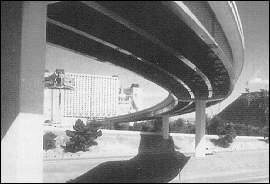 |
| Curved steel has been used in bridges for years, but there are no reliable guidelines for using it. |
Curved steel bridges represent about 20 to 25 percent of the market for steel structures yet there are no standard specifications for designing them. Since 1992, FHWA has been conducting a research project concentrating on theoretical, analytical, and experimental research findings of horizontally curved steel bridges. Having completed the initial theoretical and analytical work, the project is moving on to the experimental phase. Starting this spring, the Structures Laboratory will be used in testing the first ever, full size bridge beams inserted into a test frame designed to simulate an actual structure, and subsequently to testing of a full size bridge.
The project is funded through a joint cooperative effort between FHWA, 13 States under a pooled-fund study, and the steel industry. Because of the complex nature of the study, it is being guided by the FHWA-formed Research Council on Curved Bridges (RCCB). The RCCB includes representatives from FHWA, Transportation Research Board (TRB), participating States, industry, and academia.
The objectives of the Curved Steel Bridge Project are to conduct fundamental research into the structural behavior of curved steel flexural members and bridges, and address construction issues to provide adequate information to develop and clarify design specifications. This work consists of:
--Sheila Rimal Duwadi, (202) 493-3038.
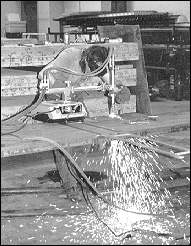 |
| HPS girders are prepared in the lab for testing. |
FHWA in cooperation with a number of States are hard at work advancing the use of high performance steel (HPS) in bridges. Two new experimental 10-m long HPS girders have been fabricated at a plant in Pennsylvania for fatigue and fracture testing at TFHRC. These steels are all weathering grades (W) and have undergone preliminary weld testing to ensure the full advantage of the new HPS. A complete testing program for these steels is being devised and will be carried out over the next several months at TFHRC.
This research is part of a multi-year program with the Carderock Division, Naval Surface Warfare Center of the Office of Naval Research, to determine optimized steels for bridge construction. The primary goal of the program includes developing 485 MPa and 690 MPa yield strength materials with an improved ability to be fabricated so that welding requires little or no preheat. The steel must also be very tough.
Many States, including Tennessee and Nebraska, have expressed interest in using these new high performance materials in actual bridges. The Tennessee DOT has awarded a construction contract for a 190-m long, two span continuous bridge fabricated entirely from HPS-485W steel.
The Nebraska DOT is moving forward on a very ambitious multi-phase implementation project for HPS. It will include building at least three bridges; the first using HPS-485W steel as a substitute for grade 50 steel; the second using wholly designed HPS-485W steel like that tested at TFHRC; and the third using a different, innovative HPS-485W to show the HPS potential for the 21st century.
--Bill Wright, (202) 493-3053.
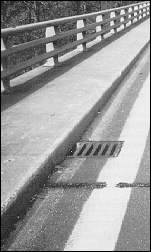 |
| New designs will improve drains such as this bridge inlet. |
Design guidance for highway related hydrologic and hydraulic issues has just improved with the publication of Urban Drainage Design Manual (FHWA-SA-96-078). It is the 22nd in a series of FHWA Hydraulic Engineering Circulars (HEC). It covers a number of topics ranging from overall drainage system planning to detailed hydraulic design procedures for roadway drainage. Essentially, everything a roadway designer or hydraulic engineer needs to know to design a highway drainage system, like one typically used in an urban area, can be found in HEC-22.
The procedures in HEC-22 update the procedures found in HEC-12, Drainage of Highway Pavements and Design of Urban Highway Drainage, The State of the Art. The procedures and guidance within HEC-22 are consistent with those presented in AASHTO hydraulic related references and are provided in metric units.
HEC-22 leads the designer through the process of designing an urban drainage system in a logical, practical format beginning with system planning and continuing through a series of design chapters. Each chapter includes example problems, and the example problems from one chapter are then used in successive chapters so the the designer can follow through an entire design. The output from computer solutions to the example problems are also given in Appendix B. A final chapter, Summary of Related Computer Programs, is provided as a reference.
The manual will be used as the primary reference to NHI's Urban Drainage Design, Course #13027. Now each course participant will take with them a publication that provides complete guidance on urban drainage design methods.
-- Chris Dunn, (503) 326-2095.
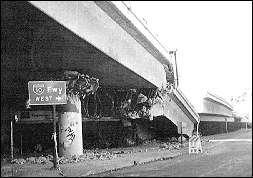 |
| Damage to bridges such as this caused by the Loma Prieta earthquake will be discussed at the conference in an effort to develop new designs that may lessen such destruction. |
Vessel collisions, earthquakes, and ground motion are some of the topics covered recently at the Designing Bridges for Extreme Events conference sponsored by FHWA's Office of Technology Applications (OTA), in conjunction with the Headquarters Bridge Division, and Region 3. The event was held last December in Atlanta and was attended by about 200 bridge and geotechnical design engineers from public and private design offices in North America, South America, Europe, and Asia/Pacific.
The purpose of the conference was to present and distribute the findings and products from a 3-year OTA-sponsored project on Extreme Events Design. Project activities included two technical working group (TWG) meetings and several TWG publications and research proposals.
The conference was divided into four sessions: Extreme Event Loading Combinations, Vessel Collision Design Procedures, Seismic Design Procedures, and Ground Motion/Seismic Hazard Design Procedures. Papers on these topics were presented by production design engineers from State DOTs, consultants and the Lawrence Livermore National Laboratory. In addition, each day ended with demonstrations of computer programs currently being used by the presenters, and informal one-on-one breakout sessions.
The conference provided both a clear picture of the state of the practice for extreme events design and the procedures by which these methodologies can be implemented.
-- Chris Dumas, (410) 962-2464.
Whether or not calcium magnesium acetate (CMA) can inhibit corrosion in chloride-contaminated reinforced concrete was the subject of an FHWA-National Academy of Science/National Resource Council postdoctoral associate study. This study evaluated the inhibiting/passivating effects of CMA when compared with other proprietary additives used as corrosion inhibitors in reinforced concrete. Sodium chloride ("road salt") was included in the study for comparison purposes.
The corrosion inhibitive potential of the various materials was evaluated using electrochemical impedance spectroscopy (EIS) procedures. An experimental set-up simulated field conditions of salt-contaminated reinforced concrete. In this simulation, EIS measurements were carried out on steel rods embedded in concrete. Rebar specimens were exposed by immersion to various inhibitor-containing deicers. The measurements were taken over a period of 11 months, generating a picture of the progress of corrosion. This afforded the opportunity to determine whether or not corrosion was accelerating with time.
The corrosovity of the various inhibitors and CMA were measured. From the data it is apparent that, as a corrosion inhibitor, CMA is superior to all other materials tested; in fact, a passivating effect is suggested (negative corrosion rate). This property, passivation, is of particular interest and significance when considering older bridge decks that are contaminated with salt. Analyses of the measurements made are detailed in the final report Impedance Spectroscopy for the Evaluation of Corrosion Inhibitors in Highway Deicers (FHWA RD-96-178). To order a copy of the report, please contact the following person.
-- Bob Kogler
| Main Constituants |
Form | Concentration | Inhibitor | pH of Solution |
|
|---|---|---|---|---|---|
| 1 | NaCL | solid | 13g/L | Mg phosphate |
7.0 |
| 2 | MgCl2 | liquid | 30g/L | citrate | 9.3 |
| 3 | NaCl | solid | 13g/L | ? | 6.1 |
| 4 | NaCl 83% MgCl2 10% |
solid | 13g/L | PCITM | 6.8 |
| 5 | MgCl2 | liquid | 35g/L | PCITM | 6.0 |
| 6 | Ca(Ac)2 30% + Mg(Ac)2 70% |
solid | 100g/L | none | 9.7 |
| 7 | NaCl | 0.2 mol/L | none | 6.8 |
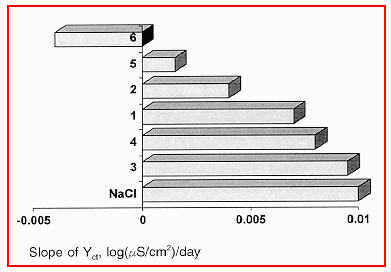
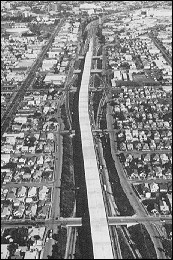 |
| Coordinated planning in congested settings like this lead to sustainable transportation. |
Sustainable transportation is a widely used catch phrase, but what does it mean? Dominic Spaethling, a Master's Degree candidate at the University of Pennsylvania, has spent his Graduate Research Fellowship assignment with the Advanced Research Team of the Office of Safety and Traffic Operations R&D working on defining sustainable transportation issues. Though formally assigned to Research and Development, he also worked closely with the Office of Environment and Planning. His assignment with FHWA was to develop a definition for sustainable transportation and to identify the elements and trade-offs involved in achieving sustainable transportation. He gave a presentation of his findings at TFHRC on March 5. They included:
-- James A. Wentworth, (202) 493-3310.
As the result of a recent study review tour by four delegates from the Republic of South Africa's Northern Province, construction has begun establishing weigh-in-motion stations which should open in South Africa this spring and an intensive highway patrol system in the fall of 1997.
In return an FHWA-sponsored scanning tour that visited South Africa last spring found valuable information pertaining to South Africa's pavements particularly the G1 base. The G1 base has a high level of densification which is enhanced through a slushing operation. Some of the pavement technology found will be tried in the United States.
Sharing these technologies are the direct result of a March 1995 Memorandum of Understanding (MOU) for technical cooperation signed by U.S. DOT (FHWA and Federal Transit Administration) and the Republic of South Africa, Department of Transport (RSADOT). Since the signing of the MOU, FHWA and RSADOT entered into a comprehensive cooperative agreement to aid the transfer of appropriate technology and road related information, including human resource development.
The implementation of these items in South Africa and the placement of pavements in the United States demonstrates the importance of sharing information internationally. We can learn from the experiences of others at the same time that U.S. highway experiences and technologies are making an impact around the world.
-- Daphne Speaks, (202) 366-6657.
FHWA has just made a big step in advancing expert system research. It has formalized information exchange and mutual support in expert systems research by entering into a cooperative research agreement through la Direction des Routes du Ministere de L'Equipement, des Transports et du Tourisme de la Republique Francaise with the Institut National de Recherche sur les Transports et leur S,curit, (INRETS), the French Government's multimodal safety research institute. Signing of this international agreement took place during the January 1997 Annual TRB Meeting.
The intent of the three tasks of the agreement are to: (1) establish the mathematical robustness of the guide for verifying, validating, and evaluating expert systems developed by FHWA; (2) perform an independent evaluation of the expert system titled Claire: A Context-Free AI-Based Supervisor for Traffic Control, which was developed under the sponsorship of INRETS; and (3) prepare direction based on experience regarding knowledge engineering for expert systems development. The Advanced Research Team of the Office of Safety and Traffic Operations R&D and the Applied Mathematics and Artificial Intelligence Department of INRETS will be jointly conducting the research.
-- Jim Wentworth.
Advanced statistical techniques are being used with increasing effectiveness for highway safety analysis. Three recently completed studies developed and evaluated the latest statistical techniques and how they can best be used.
In highway safety studies, a numerical measure of exposure to opportunities for crashes is required. Because of the difficulty of obtaining numerical exposure estimates, indirect methods have evolved for treating the issue in a surrogate manner. The first study conducted a review of methods to indirectly account for exposure in highway safety studies. The strengths and limitations of the various methods (induced exposure, case-control studies, and before/after evaluation designs) were assessed. The report Indirect Methods to Account for Exposure in Highway Safety Studies (FHWA-RD-96-141) serves as a guide for the highway safety researcher in the use of indirect methods for determining exposure in designing and evaluating highway safety studies.
The second study improved and tested a statistical methodology for identifying and correcting for regression-to-the-mean bias in two safety applications: evaluating safety countermeasures and identifying problem locations. This study discovered the practical limitations of implementing the methodology and identified the magnitude of the regression-to-the-mean problem. The results are useful to researchers and analysts interested in the practical challenges of applying advanced statistical methods (specifically the Empirical Bayes method) to safety data. The results of this study have been published in the report Evaluation of Accident Analysis Methodology (FHWA-RD-96-039).
In developing accident prediction models, the R2 goodness-of-fit measure has been used by researchers for many years to: (1) determine the quality and useability of a model; (2) select covariates for inclusion in the model; (3) make a decision as to whether it would be worthwhile to collect additional covariates; and (4) compare the relative quality of models from different studies. The third study demonstrated the pitfalls of using R2 to make these decisions and comparisons. In addition, the study developed and evaluated alternative goodness-of-fit measures for generalized linear models to determine which ones have desirable properties. The report Measuring the Goodness-of-Fit of Accident Prediction Models (FHWA-RD-96-040) should be of interest to researchers and analysts responsible for developing and evaluating statistical models for safety and other fields of transportation. For copies of these reports, call the following person.
-- Michael S. Griffith.
On February 24, the Garrett A. Morgan Association (GAMA) presented its annual Trailblazer Award to Dr. Ilene Payne, Director of the National Highway Institute's (NHI) Universities and Grants Programs(pictured). She was recognized for her outstanding commitment to diversity, communication among employees, community service, and professional achievement. The presentation was part of an African American History Month event co-sponsored by FHWA's Office of Civil Rights and GAMA, and held in DOT Headquarters' Oklahoma City Memorial Room. Julian Bond, civil rights activist and former Georgia State legislator, delivered keynote remarks, arguing for continued support of affirmative action to ensure that the civil rights gains of recent decades become firmly rooted in a system of equal opportunity and economic justice in which all Americans can prosper.
In her 21-year career with FHWA, Dr. Payne has consistently striven to advance diversity and opportunity, first with the Office of Civil Rights and then with the NHI. Dr. Payne administers the Dwight David Eisenhower Transportation Fellowship Program, which provides undergraduate and graduate fellowships to engineering and transportation students. GAMA was founded in 1991 by FHWA employees, drawing its name and its inspiration from the African American inventor of the first three-position traffic signal.
-- Morris Oliver, (202) 366-2251
A series of application projects using neural networks is being planned as the result of informal contacts at a recent neural network mini-conference sponsored by FHWA's Advanced Research Team in cooperation with The George Washington University. This forum and the plans it helped generate are so useful, preliminary arrangements are in progress for a second conference at GWU Virginia.
The first project which came out of the forum involves a warning system for drowsy drivers. This study will use a neural network to determine if sufficient measurable parameters exist from which to base a warning system for drowsy drivers. There is a data base available on sleep deprived subjects who were asked to drive in the TFHRC Driving Simulator while their performance was monitored. That data will form the training set for the neural network, and the resulting model will be assessed with respect to its potential use as a warning system.
The second project that came out of the forum involves the use of a neural network and/or multi-dimensional visualization methods to more clearly identify the relationships between chemical properties and physical properties of asphalt, especially the non-linear rheological properties. The long-range goal is to use these relationships in combination with particulate mechanics models, non-linear continuum mechanics methods, and then search for improvements of asphalt pavement systems with these new models. A more focused problem definition is the immediate objective, after which a more detailed project plan will be developed.
In addition to work at TFHRC, various FHWA contract research projects have also used neural networks, especially in the traffic control and image processing areas. Based on the above projects and contract activity and numerous informal neural network discussions at TFHRC, planning for a second conference on neural networks in highway and vehicle engineering seemed appropriate. The tentative target date is next spring and a formal announcement and call for papers will appear in the Transporter. Tentative plans are to have one or more sessions dedicated to presentations that respond to a wish-list of neural network applications as suggested by Government, State, or private transportation specialists. If any readers have interesting suggestions, please contact the following person.
-- Mort Oskard